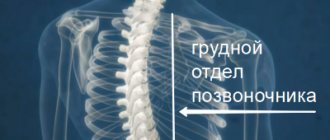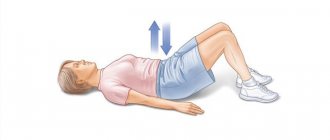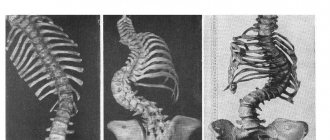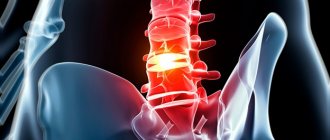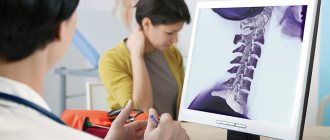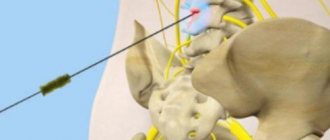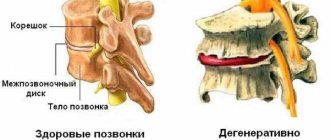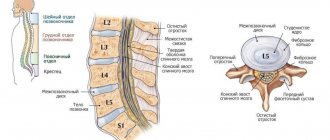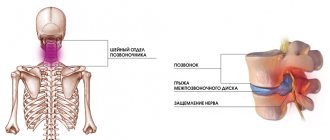Osteochondrosis in the thoracic region develops extremely rarely, since this area of the back is little active. But the emerging pathological process causes acute pain, stiffness and decreased performance. Therefore, for prevention and comprehensive treatment, it is recommended to regularly perform exercises for the thoracic spine for osteochondrosis. Compliance with the technique and strict adherence to the algorithm allows you to achieve significant results, improve the condition of your back, and restore normal mobility to it.
Benefits of exercise
Exercises for the treatment of osteochondrosis and other pathologies of the musculoskeletal system allow you to achieve a lasting therapeutic effect from the chosen treatment tactics. The complex is developed by a doctor, taking into account the severity of symptoms, the presence or absence of acute pain, contraindications and diagnosis of concomitant pathologies.
Osteochondrosis provokes fusion of the vertebrae. Thus, the area becomes motionless, and the person loses the ability to move normally, perform simple actions and take care of himself.
Properly selected physical therapy can achieve the following results:
- Relaxation of the back muscles.
- Formation of a strong muscle corset.
- Elimination of unpleasant symptoms.
- Slowing down or completely stopping the progression of osteochondrosis.
- Minimizing the likelihood of severe complications.
- Strengthening lung ventilation, eliminating the development of pneumonia, which is not uncommon in the chest form of the pathology.
Even simple exercises for thoracic osteochondrosis can eliminate muscle stiffness, relieve pain and restore mobility of this part of the spine. Long-term exercises under the supervision of a specialist help to achieve more significant results and achieve stable remission of the disease.
Contraindications and side effects
Exercise therapy for osteochondrosis is contraindicated in the following cases:
- postoperative period;
- inflammatory diseases;
- acute pain in the spine;
- the presence of malignant tumors;
- hypertension;
- increased intracranial pressure;
- hernia;
- diseases of the cardiovascular system.
It is also not recommended to perform exercises with osteochondrosis if you are in poor general health and weak. At the initial stage, there may be increased pain or increased temperature, but these are temporary phenomena.
Therapeutic gymnastics as a type of treatment
Exercises for thoracic osteochondrosis are selected by the doctor depending on the stage of development of the pathological process. It is the basis, but is always used in combination with other therapy methods (taking medications, manual therapy, massage, physiotherapy, wearing a corset). Regular training helps to form a strong muscle corset that supports the spine in an anatomically correct position and protects the vertebrae from displacement.
Exercise therapy for thoracic osteochondrosis allows you to maintain the mobility of this area of the back, normalize the functioning of the respiratory system and ensure the normal functioning of internal organs. Correct execution of the approaches ensures the restoration of the correct curves of the ridge and will eliminate the main symptoms of the pathological process.
A simple complex to perform at home
Complex in a standing position
The lesson is carried out standing, the starting position is feet shoulder-width apart, back straight, arms at your sides, shoulder girdle relaxed. The complex includes the following approaches:
- Stand up straight, place your hands on your belt, and perform partial circular bends. In the process, a load should be felt on the thoracic region, and a pleasant warmth should spread through the soft tissues.
- Stand up straight, clasp your hands. When turning the body, place them behind your head and pull back.
- Take a long towel or cloth and wrap it around your chest. Holding the ends as you exhale, tighten it.
- Place your hands behind your head and bend to the right and left, everything is done smoothly, while controlling the load on the muscles.
- Stand on your toes and stretch your arms up. Hold for a few seconds and return to the starting position.
At first, the exercises are performed relaxed, without sudden movements and serious muscle loads. A gradual increase in intensity and amplitude allows you to avoid injury and achieve lasting results.
Complex in supine position
Some patients are advised to exercise in a lying position. The main requirement in this case is surface hardness. A soft bed or couch is not suitable for this; it is better to spread a rug on the floor. The complex includes the following approaches:
- Lie on the floor, place a rolled small towel under your back, and gradually lift your body. Hold for a few seconds and return to the starting position.
- Lie on the floor, relax. As you inhale, bring your shoulder blades together, while lifting your chest upward. Hold the position for a few seconds and then return to the starting position.
- Lie on your stomach, extend your arms in front of you and slightly raise your body. The body should be supported a little on the weight, as long as there is enough strength for this and as far as physical training allows.
Each approach is repeated 7-10 times. This is enough to load muscle tissue and gradually strengthen it. The number of repetitions increases gradually as you get used to it.
Complex in a sitting position
Many patients find it convenient to perform exercises to eliminate osteochondrosis of the thoracic region in a sitting position. A stool or regular chair is used for this. During the execution, it is important to focus on the back of the chair.
Therapeutic exercises for widespread osteochondrosis of the spine
- Sit up straight, press your shoulders to the back, try to bend back as much as possible, and then slightly bend forward.
- Sit up straight, put your hands on your shoulders, gradually lift them, while feeling the resistance of your palms.
- Holding the back of the chair on the right side with your left hand, slowly turn your body. After changing hands, repeat the exercise.
It is enough to repeat 5-7 approaches, while controlling the degree of muscle tension. If pain or discomfort occurs, stop the activity and consult a doctor.
Osteochondrosis of the thoracic spine: causes
Osteochondrosis is a term used to describe a wide range of skeletal lesions in humans and animals. This disease is most common in children and adolescents, and in animals - fast-growing horses, dogs, pigs and chickens. During the development of osteochondrosis, the blood supply to the bone is interrupted, resulting in localized necrosis. In the development of the disease, nutritional, hereditary, endocrine factors, as well as biomechanical effects and disturbances in the blood supply of growing cartilage, play an important role.
Osteochondrosis is accompanied by pain associated with the localization of bone damage. Some types of the disease, depending on the location of the skeletal lesion, may be accompanied by swelling, lameness, curvature or kyphosis of the upper spine.
Osteochondrosis can be divided into three groups:
- Spinal: Scheuermann-Mau disease is a curvature of the thoracic spine.
- Articular osteochondrosis: Legg-Calvé-Perthes disease (avascular necrosis of the femoral head), Keller disease (aseptic destruction of the tarsal or navicular bones of the foot), Panner disease (osteochondritis dissecans of the head of the elbow) and Freiberg disease (osteochondropathy of the head of the second or third metatarsal bone of the foot) .
- Non-articular osteochondrosis: Sever's disease (calcaneus or heel) and Kienbock's disease (hand), as well as conditions not always characteristic of osteochondrosis, such as Osgood-Schlatter disease (a tubercle on the tibia) and osteochondritis dissecans2.
Osteochondrosis can occur in any part of the spine: in the cervical region (osteochondrosis CS), in the thoracic region (osteochondrosis TS) and in the lumbar region (osteochondrosis LS).
Osteochondrosis of the thoracic spine is associated with wear and changes in the intervertebral disc. These fibrous rings are located between the vertebrae and act as shock absorbers during impacts. Due to strong pressure, the discs become deformed and lose their ability to regenerate. This results in the formation of bone spurs that can cause pain and severely limit the mobility of the spine.
Intervertebral discs, like other parts of the body, are subject to natural wear and tear. However, there are a number of factors that accelerate this process:
- Excessive physical activity, heavy lifting.
- Intervertebral disc infections.
- Herniated intervertebral discs.
- Spinal fracture.
- Scoliosis, pelvic displacement.
- Excess weight.
- Diabetes.
- Smoking.
Osteochondrosis of the thoracic spine is difficult to diagnose independently. To prevent the development of the disease, you should pay attention to the following manifestations:
- pain in the cervical and shoulder regions, in the area of the shoulder blades;
- tension and pain in the lower back and spine;
- a state of prolonged fatigue, apathy, drowsiness;
- numbness of the upper extremities (fingers, hands and arms);
- difficulties in flexing and straightening limbs;
- short-term loss of orientation when turning the body and head;
- nausea, dizziness, loss of balance;
- noise in ears;
- sharp pain with normal movements 3.
Alexandra Bonina complex
With the development of osteochondrosis of the thoracic region, many doctors recommend classes according to the author’s system of Alexandra Bonina. It allows you to reduce the manifestation of unpleasant symptoms and strengthen the muscle corset in a short time. The complex includes only 7 basic exercises:
- Sit straight on a chair, lean your back on it and place your arms along your body, relaxing them as much as possible. Gradually, the shoulders are pulled back to connect the shoulder blades together. You will need to stay in this position for 2-3 seconds, then relax your back and return to the original position. During the process, it is important to control the position of the ridge, since only the shoulders should work.
- Sit on a chair, use the back as support, relax your arms and place them along your body. One hand is gradually moved to the side, then up, returns to the side again and drops to the bottom. The same actions are repeated with the other hand. In the process of performing an action, control of body position is required. Only the upper limbs should be active, the remaining parts are fixed and motionless.
- Sitting on a chair, place your hands in front of you and relax. Connect your palms and press them against each other for 5-7 seconds. Then relax, take a break and repeat the action several more times.
- Sit on a chair, focus on the back, place your right hand just above your chest, place your left hand on your solar plexus. Take a full chest breath, filling the lungs through the nose, and gradually exhale through the mouth. During the process, the stomach is practically not involved, the lower arm should not change position.
- Sit up straight, relax your arms and hang them along your body. Raise your shoulders up and gradually move them back, trying to connect your shoulder blades. After this, the chest bends forward and the shoulders drop down. Such circular movements are made almost without stopping; if necessary, short breaks are acceptable.
- Lie on your back, bend your knees, and place emphasis on your feet. Place your hands behind your head and clasp them together. Twisting is gradually done, aimed at the upper section. Hold for a few seconds and gradually lower down.
- Get on all fours, stretch your left hand as far as possible to the right side, after which it returns to its original position. The same is done for the other side. During the process, you should feel a stretch in your back muscles.
You should start your classes by doing 5 exercises, gradually increasing their number. It is extremely important to pay attention to technique, since the effectiveness of training will directly depend on this.
A simple and effective complex for osteochondrosis
How to strengthen the thoracic spine
Of course, it is best to prevent spinal diseases from occurring. But, if you feel back pain, notice a curvature of the spine, or have been diagnosed with a musculoskeletal disease, start working on the problem! Even in the case when doctors say that the curvature is insignificant and nothing can be done at present. The sooner you start strengthening your back, the more likely you are to stop the progression of the disease.
Relaxation is an important step on the path to health. Practice breathing exercises (pranayama): full yogic breathing, breath stretching, anuloma viloma pranayama. These techniques will help relax the body and mind, allow you to calm down and remove tension in the muscles.
Not only exercises to strengthen the thoracic spine help, but also lifestyle changes. If you have a sedentary job, you need to create a schedule that allows you to take breaks and exercise.
Watch your posture
Today people spend more and more time on their phones. The position with the head tilted forward compresses the spinal cord and blood vessels, leading to displacement of the vertebrae.
Don't sleep on your stomach
This is the worst position for scoliosis because it causes the thoracic region to flatten. Scoliosis is three-dimensional: if the condition worsens in one plane, then it also worsens in others. Sleeping on your stomach also requires turning your head to the side, which increases the curvature of the spine.
Don't run long distances
Every time you take a step, the vertebrae are compressed. And this leads to the progression of changes in the spine. Therefore, it is better to limit not only running, but also jumping and horse riding or even exclude it from practice.
Don't carry heavy things
When you carry a heavy bag with one hand, the deformation of the spine increases. A backpack worn on both shoulders is best suited for such purposes.
Change your position more often
Sitting or standing in one place for too long increases the stress on the spine. Exercise or go for walks more often. If you have a sedentary job, choose a chair with good support.
Unfortunately, diseases of the musculoskeletal system are firmly rooted in people's lives. As the studies above show, more than half of the cases of scoliosis, osteochondrosis and kyphosis are idiopathic.
In other words, the cause of their occurrence is unknown. Therefore, any person is at risk. We are required to take daily care of the spine and be attentive to our health. A healthy lifestyle, regular physical activity and a clear daily routine will help minimize the risk of developing diseases,
which are very difficult to treat.
Breathing exercises
Training must be carried out with mandatory breathing control. Therefore, it is recommended to include elements of breathing exercises in the complex, which also stimulate muscle function and prevent the development of pathological processes (bronchitis, pneumonia). Classes by Strelnikova A.N. are effective:
- Stand up straight, bend your arms, lower your elbows.
- Turn your palms towards the ceiling.
- Take 4 short but rapid breaths through your nose, clenching your fists.
- Lower your hands and take a break of 4 seconds.
- Repeat the exercise 5 times.
Breathing exercises for thoracic osteochondrosis ensure the natural position of the spine, develop deep breathing, ventilate the lungs, and prevent the development of complications.
Features of exercise therapy at home
Therapeutic exercises for the development of osteochondrosis are carried out at home, in the absence of contraindications in the initial stages. To perform the approaches, no special equipment is required; all work is done with your own weight. The complex includes the following exercises:
- Stand up straight and straighten your back. Extend your arms to the sides, parallel to the floor. It is important to ensure that your shoulders are not raised. In this position, twisting is done in the chest area. At the same time, the hips remain motionless. At the end point of the turn, you should linger for 20 seconds, then return to the original position and repeat the action in the other direction.
- Stand up straight, lower your arms along your body, lower yourself forward so that your arms hang down, your shoulders and back are relaxed, and your abdominal muscles are slightly tense. Stay in this position for a few seconds, then return to the starting position. This is done gradually, the head rising last.
- Stand up straight, press your arms to your sides, and then slowly bend to the right and left. If your physical fitness allows you to use light weight dumbbells.
- Lie on your stomach, clasp your ankles with your hands so that your body forms a boat. When your arms cannot reach, it is enough to stretch them as far back as possible and lift your legs off the floor.
- Get on all fours, bend upward as you inhale, and bend down as you exhale.
Therapeutic gymnastics at home allows you to achieve excellent results and increase back flexibility. But training should be abandoned during acute viral diseases, as well as in the presence of skin disorders, injuries, and deep cuts.
Traditional treatment
Therapy for thoracic osteochondrosis is carried out in several ways, based on indications:
- Conservative treatment.
- Traction.
- Surgical intervention.
The most commonly used drugs are medications . The basic principles of such therapy:
- Pain relief - glucocorticosteroids and anti-inflammatory drugs.
- Improvement of cartilage tissue - chondoprotectors (Alflutop).
- Preservation of fluid in the disc - Papain.
- Reduce muscle spasms - muscle relaxants.
If a hernia occurs, surgery is often required. But it is prescribed only after differential diagnosis in order to exclude similar pathologies.
Additional methods are also used:
- Physiotherapy - electrophoresis, magnetotherapy, ultraviolet exposure.
- Acupuncture.
- Massage.
- Physiotherapy.
Without physical exercise, treatment will be pointless, but only a doctor should formulate complexes.
Exercises for exacerbation of osteochondrosis
When osteochondrosis worsens, doctors recommend refraining from exercise or any physical activity. But in some cases, simple approaches and actions help normalize muscle tone, eliminate chronic pain, and improve blood flow. In bed rest conditions, the choice of suitable work methods is limited. The main set of exercises in the acute stage:
- While lying on your stomach, spread your arms to the sides. Tilt your head back and stay in this position for 5 seconds, then return to the starting position.
- Lie on your back, stretch your arms out in front of you, raise your legs and try to reach them with your fingers.
- Get on your knees, lower your hands. As you inhale, raise your arms up and down, tilt your body forward. As you exhale, sit on your heels.
- Tighten your abdominal muscles, relax, then bring your shoulder blades together and return to your abdominal muscles. Repeat the complex several times.
Therefore, all approaches are performed in bed. For convenience, a soft cushion is located in the area of the shoulder blades. The time spent working with muscles is no more than 10 seconds for each approach. If warmth appears at the point of tension, it means the patient is working correctly.
At the beginning of exercise therapy classes are carried out exclusively under the supervision of a doctor.
Contraindications for implementation
Acute, piercing pain in the back, radiating to the hips and shoulder blades, is an absolute contraindication for exercising. You should not perform exercises in the following pathological conditions:
- tachycardia, bradycardia;
- severe dizziness, loss of coordination of movements;
- high or low blood pressure;
- respiratory, intestinal infections;
- elevated body temperature.
Training should be postponed in case of exacerbation of other chronic diseases. If you have recently undergone surgery, then performing exercises is strictly prohibited.
Rules for training
Physical therapy exercises in the last stages of the disease should be done under the supervision of a specialist. He will monitor not only the correct technique, but will also regulate the permissible load and eliminate actions that could harm the already fragile condition of the back. In the first and second stages, physical exercises can be done at home. But here you need to follow a number of simple rules:
- It is undesirable to start exercising during the acute period, since the main goal of the treatment process at this time will be to eliminate pain and ensure complete rest of the back.
- All approaches are performed in a ventilated room where the temperature is not higher than 20 degrees.
- For classes, you should choose comfortable clothes that do not restrict movement.
- It is important to control your breathing with each approach. There should be no severe shortness of breath or change in the intensity of inspiration.
- The complex is selected by the doctor regardless of the stage of the disease. Even if there are risk factors and the choice of preventive methods, additional consultation will help avoid the development of undesirable consequences.
- If pain or discomfort occurs, the activity should be stopped.
- To achieve maximum effect, you need to conduct training at the same time, according to a certain algorithm. Start with a warm-up to prepare the muscles for the load, and gradually increase the load.
- You need to devote 10-25 minutes a day to the lesson; the process does not require the use of equipment, it is enough to work with your own body weight.
After performing the exercises, it is recommended to take a warm shower to effectively relax the muscles. Let's allow a light massage of the back and limbs, which will improve blood circulation and give pleasant sensations. Excessive physical influence is unacceptable, only light stroking and patting. Otherwise, they will do more harm than good.
Gymnastics for osteochondrosis of the thoracic region is an important part of treatment, as it allows you to consolidate the results obtained from taking medications and physiotherapeutic procedures. It is prescribed by a doctor in the form of a complex of exercise therapy, which the patient does regularly in compliance with the basic rules and techniques. Despite their simplicity, exercises can improve the condition of the muscular corset, which provides support and correct position of the spine.
Kyphosis and scoliosis of the thoracic spine
Scoliosis is a curvature of the spine to the left or right, as well as around its axis. Most often, the disease develops in children from 9 to 14 years old, during puberty. In most cases, scoliosis develops gradually and painlessly. Sometimes mild to moderate scoliosis can develop unnoticed. If scoliosis is mild, it does not require treatment. In difficult cases, treatment includes special gymnastics, back bracing, or surgery to straighten the spine.
The curvature in scoliosis can be in the lower part of the spine (lumbar curve), in the upper part of the spine (thoracic curve), or go from the top to the bottom of the spine (thoracolumbar curve). In some cases, a double curve appears, forming an S-shape4.
There are several types of scoliosis, each with different causes.
Non-structural scoliosis (functional or postural scoliosis) involves curvature of the spine due to different leg lengths or muscle spasm in the back. The back straightens when a person changes position.
Structural scoliosis is a fixed curvature that does not go away with changes in position. This type of scoliosis has several types:
Idiopathic scoliosis involves an unknown cause. This is the most common type, occurring in 8 out of 10 people.
Neuromuscular scoliosis is caused by a special condition of the muscles or nerves in the back, such as in people with muscular dystrophy, polio, cerebral palsy, or neurofibromatosis. Each of these conditions has other symptoms and problems besides scoliosis. In about 1 in 10 people, scoliosis is associated with a neuromuscular problem.
- Osteopathic scoliosis is caused by a bone abnormality.
- Congenital scoliosis develops in a baby in the womb.
